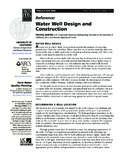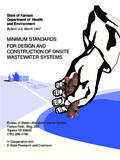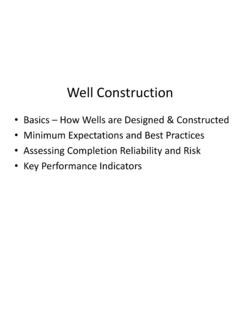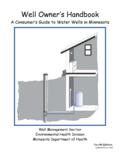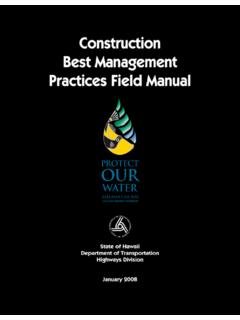Transcription of A Guide To Water Well Casing and Screen Selection …
1 A Guide To Water well Casing and Screen Selection A Note About Roscoe Moss Company Roscoe Moss Company, publisher of this Guide , has been engaged in the development of ground Water since the 1890's. Originating as a Water well drilling contractor operating in the Southwest, the firm has constructed thousands of wells throughout the United States and in ten foreign countries. In 1926, Roscoe Moss began the manufacture of Water well Casing and screens. Emphasis on the development of these products has brought the company to the forefront of specialists in the marketing of these materials. Completing its uniqueness as a firm engaged in all phases of ground- Water development, Roscoe Moss has an active interest in two large California Water utilities serving million people. Included in their supply sources are over 500. high capacity Water wells. The material contained in this pamphlet is in based on a broad practical knowledge of Water well design, construction , operation and maintenance, as well as steel products manufacture.
2 These resources are enhanced by an ongoing systematic research and evaluation program. We are pleased to share the information following, some of which represents proprietary company knowledge and has never before been published. A Guide To Water well Casing and Screen Selection Table of Contents .. 4. METHODS OF well construction .. 6. Cable Tool .. 6. Rotary .. 7. GENERAL Casing AND Screen CONSIDERATIONS AND MATERIALS 9. Strength and Durability .. 9. Handling and Maintenance .. 9. Economy .. 10. Steel .. 10. Non-Ferrous .. 10. MANUFACTURING PROCESSES AND END USE COMPARISONS .. 11. Electric Resistance Welded .. 11. Seamless .. 11. Press Formed .. 12. Fabricated .. 12. Spiral Weld .. 12. Corrosion .. 13. Dimensions .. 13. Availability .. 14. Substandard Pipe .. 14. Casing REQUIREMENTS .. 15. Diameter .. 15. Wall Thickness .. 16. Corrosion Resistance .. 18. Conductor Casing .
3 20. well Screen REQUIREMENT .. 21. Aperture Size and Internal Design .. 21. Economy .. 21. Entrance Velocity .. 21. Maintenance and Future Contingencies .. 22. Screen DESIGNS .. 23. Torch Cut Slots .. 23. Milled Slots .. 23. Wire Wrap .. 24. Bridge Slot .. 25. Shutter Screen .. 25. END CONNECTIONS AND ACCESSORIES .. 27. Threaded and Coupled .. 27. Plain Ends .. 27. Bell and Spigot End .. 28. Welding Collars .. 28. Stainless Steel to Carbon Steel Connections .. 28. Compression Sections .. 29. Landing Clamps .. 29. Casing Guides .. 31. Float Plates .. 31. Diameter Reduction .. 31. Bottom Plugs .. 32. APPENDICIES AND TABLES .. 33. Appendix I - well Efficiency .. 33. Appendix II - Formation Sampling, Filter Pack & Aperture Size Selection 34. Appendix III - Analysis of Driving Casing with Cable Tool Equipment 37. Appendix IV - Water Sampling for Chemical Analysis.
4 39. Table A - Head Losses Through Pipe .. 40. Table B - Physical Characteristics Blank Casing .. 41. Table C - Specifications Steel Pipe .. 43. Table D - Specifications Steel .. 45. Table E - Conversion Table .. 47. INTRODUCTION. Water has played a vital role in the advancement of mankind. The earliest traces of civilization reveal that those cultures which flourished were able to employ Water sources for domestic, and agricultural purposes. A characteristic of all developed countries today is their ability to use productively the Water made available to them. While ground- Water use began in arid and semi-arid regions thousands of years ago, more recently development has occurred in areas with ample surface supplies. This has provided supplemental sources for use by agriculture at the most beneficial time during the growing season and availability construction of Los Angeles Aqueduct, 1907-1913.
5 During drought conditions. Thus, a world ground- Water development industry has grown, focusing attention on Water well construction techniques, design and operating methods. The scope of the investigation included plotting of a typical geologic cross section through the Pleasant Valley aquifers and a computer analysis and comparison of specific capacities per foot of Screen for each of the wells. Regardless of purpose, almost all Water wells must be provided with a means of protecting the borehole and provision made for the entrance of Water from surrounding aquifers. While well Casing is simply defined as the material that cases or lines a borehole to prevent formation collapse, there are varied interpretations of the meaning of well Screen . This is due to the existence of many designs throughout the world. In this Guide , Screen refers to that structure in a well , which protects the borehole, but allows the entrance of Water .
6 In this sense, Screen is a filter. The durability and efficiency* of a well depend to a large degree on its design, construction procedures and Selection of Casing and well Screen . However, casings and screens alone comprise the principal substance of a completed Water well . *An explanation of well efficiency appears in Appendix 1. While representing a fraction of total investment, they are critical to the productive life of a well and pump. In addition, yield and operating expenses are influenced. The latter has grown more important due to rapidly escalating energy costs. Another matter attracting increased attention today concerns contamination of ground- Water supplies from harmful materials originating at the surface. Protection of a well requires controlling the pollution source. In many cases, the use of sealed casings and more durable materials is helpful.
7 This pamphlet discusses Casing and Screen materials in common use in the word today. It also sets forth the factors to be considered in their choice. These factors include methods of well construction and their relationship to well design. While a complete answer to every planning requirement cannot be provided here, the information following may be used a s a general Guide by those concerned with ground- Water development. METHODS OF well construction . Cable Tool There are several methods of drilling Water wells today. These relate to particular well design and Casing and Screen requirements. A brief discussion of these techniques is presented below. Many wells today are being drilled by a method which is centuries old. Although cable tool (percussion) drilling rigs and tools have changed, the basic principles involved in this system have remained the same. The borehole is drilled by the pulverizing action of a reciprocating steel bit suspended from the drilling rig by a wire cable.
8 As the bit strikes the bottom of the hole, the formation is crushed, creating cuttings which are removed by bailing. If the formation is loose and unconsolidated, the Casing must be forced in to the hole periodically to prevent caving. Several procedures are available for completing wells drilled by the cable tool method. If Casing is installed as the hole is drilled, it may be perforated by down-the-hole tools, forming a Screen opposite the Water -producing formations. With most methods of down-the-hole perforating, a small aperture cannot be formed nor can the aperture size be precisely controlled. Consequently, finer-grained aquifers must be avoided. In general practice, the cable tool method lends itself more to drilling coarser, harder formations. In some regions Casing is installed to the total depth and a Screen telescoped through the Casing to the bottom.
9 The Casing is then withdrawn partially to expose the Screen to the aquifer or aquifers. A variation of this method, permitted under certain drilling conditions, is installation of Casing to the top of the aquifer and drilling additional open borehole to accommodate the Screen , which is installed by lowering into place. With the advent of rotary drilling methods, these techniques are rarely used. Down the hole hydraulic louver perforator. Small diameter wells for domestic purposes, drilled in tight, consolidated formations, are constructed with cable tools or down-the-hole air hammer. These wells often only need a surface conductor Casing installed through the unconsolidated overburden. Water is produced from the open hole. In some cases, a protective Casing is installed to the depth of the pump. Under favorable drilling conditions and where the aquifers Screen formed by are well known, screens in the form of preperforated casings perforating Casing in can be installed as the borehole is drilled.
10 Such preperforated Casing are normally slotted vertically for greater compressive strength to withstand being driven into place. The driller must be sure that he can carry the screens to the planned depth opposite the aquifers. Rotary During the last 30 years, the use of direct rotary and reverse circulation rotary drilling methods has come to dominate the construction of higher capacity Water production wells. Both rotary methods are linked with the gravel envelope well design. With the direct rotary method, a rotating bit under controlled loading is applied to the formation. Water with additives to provide weight and viscosity is pumped down the drill pipe, through the bit, and circulates up the hole carrying the cuttings, which are separated and removed at the surface. Usually the finished borehole is accomplished in two or more stages. A smaller pilot bore is drilled first, then reamed to a diameter 6 to 12 inches greater than that of the Casing and Screen .

